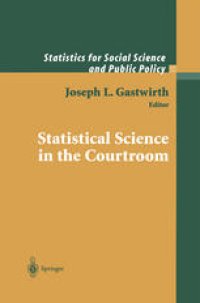
Ebook: Statistical Science in the Courtroom
- Tags: Statistics for Social Science Behavorial Science Education Public Policy and Law
- Series: Statistics for Social Science and Public Policy
- Year: 2000
- Publisher: Springer-Verlag New York
- Edition: 1
- Language: English
- pdf
Expert testimony relying on scientific and other specialized evidence has come under increased scrutiny by the legal system. A trilogy of recent U.S. Supreme Court cases has assigned judges the task of assessing the relevance and reliability of proposed expert testimony. In conjunction with the Federal judiciary, the American Association for the Advancement of Science has initiated a project to provide judges indicating a need with their own expert. This concern with the proper interpretation of scientific evidence, especially that of a probabilistic nature, has also occurred in England, Australia and in several European countries. Statistical Science in the Courtroom is a collection of articles written by statisticians and legal scholars who have been concerned with problems arising in the use of statistical evidence. A number of articles describe DNA evidence and the difficulties of properly calculating the probability that a random individual's profile would "match" that of the evidence as well as the proper way to intrepret the result. In addition to the technical issues, several authors tell about their experiences in court. A few have become disenchanted with their involvement and describe the events that led them to devote less time to this application. Other articles describe the role of statistical evidence in cases concerning discrimination against minorities, product liability, environmental regulation, the appropriateness and fairness of sentences and how being involved in legal statistics has raised interesting statistical problems requiring further research.
Expert testimony relying on scientific and other specialized evidence has come under increased scrutiny by the legal system. A trilogy of recent U.S. Supreme Court cases has assigned judges the task of assessing the relevance and reliability of proposed expert testimony. In conjunction with the Federal judiciary, the American Association for the Advancement of Science has initiated a project to provide judges indicating a need with their own expert. This concern with the proper interpretation of scientific evidence, especially that of a probabilistic nature, has also occurred in England, Australia and in several European countries. Statistical Science in the Courtroom is a collection of articles written by statisticians and legal scholars who have been concerned with problems arising in the use of statistical evidence. A number of articles describe DNA evidence and the difficulties of properly calculating the probability that a random individual's profile would "match" that of the evidence as well as the proper way to intrepret the result. In addition to the technical issues, several authors tell about their experiences in court. A few have become disenchanted with their involvement and describe the events that led them to devote less time to this application. Other articles describe the role of statistical evidence in cases concerning discrimination against minorities, product liability, environmental regulation, the appropriateness and fairness of sentences and how being involved in legal statistics has raised interesting statistical problems requiring further research.
Expert testimony relying on scientific and other specialized evidence has come under increased scrutiny by the legal system. A trilogy of recent U.S. Supreme Court cases has assigned judges the task of assessing the relevance and reliability of proposed expert testimony. In conjunction with the Federal judiciary, the American Association for the Advancement of Science has initiated a project to provide judges indicating a need with their own expert. This concern with the proper interpretation of scientific evidence, especially that of a probabilistic nature, has also occurred in England, Australia and in several European countries. Statistical Science in the Courtroom is a collection of articles written by statisticians and legal scholars who have been concerned with problems arising in the use of statistical evidence. A number of articles describe DNA evidence and the difficulties of properly calculating the probability that a random individual's profile would "match" that of the evidence as well as the proper way to intrepret the result. In addition to the technical issues, several authors tell about their experiences in court. A few have become disenchanted with their involvement and describe the events that led them to devote less time to this application. Other articles describe the role of statistical evidence in cases concerning discrimination against minorities, product liability, environmental regulation, the appropriateness and fairness of sentences and how being involved in legal statistics has raised interesting statistical problems requiring further research.
Content:
Front Matter....Pages i-xxii
Interpretation of Evidence, and Sample Size Determination....Pages 1-24
Statistical Issues in the Application of the Federal Sentencing Guidelines in Drug, Pornography, and Fraud Cases....Pages 25-50
Interpreting DNA Evidence: Can Probability Theory Help?....Pages 51-70
Statistics, Litigation, and Conduct Unbecoming....Pages 71-85
The Consequences of Defending DNA Statistics....Pages 87-97
DNA Statistics Under Trial in the Australian Adversarial System....Pages 99-124
A Likelihood Approach to DNA Evidence....Pages 125-141
The Choice of Hypotheses in the Evaluation of DNA Profile Evidence....Pages 143-159
On the Evolution of Analytical Proof, Statistics, and the Use of Experts in EEO Litigation....Pages 161-194
A Connecticut Jury Array Challenge....Pages 195-225
Issues Arising in the Use of Statistical Evidence in Discrimination Cases....Pages 227-243
Statistical Consulting in the Legal Environment....Pages 245-262
Epidemiological Causation in the Legal Context: Substance and Procedures....Pages 263-280
Judicial Review of Statistical Analyses in Environmental Rulemakings....Pages 281-301
Statistical Issues in the Estimation of the Causal Effects of Smoking Due to the Conduct of the Tobacco Industry....Pages 303-320
Forensic Statistics and Multiparty Bayesianism....Pages 321-351
Warranty Contracts and Equilibrium Probabilities....Pages 353-362
Death and Deterrence: Notes on a Still Inchoate Judicial Inquiry....Pages 363-377
Introduction to Two Views on the Shonubi Case....Pages 379-391
The Shonubi Case as an Example of the Legal System’s Failure to Appreciate Statistical Evidence....Pages 393-403
Assessing the Statistical Evidence in the Shonubi Case....Pages 405-413
....Pages 415-443